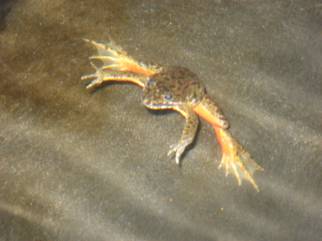By Graduate Research Associate Sarah Weber
The Oregon spotted frogs (OSF) at Cedar Creek Corrections Center (CCCC) are the subjects of a growth comparison study between two separate OSF populations: Black River and Conboy Lake. Inmates at CCCC are raising the two populations side-by-side in separate tanks, keeping all rearing conditions identical, in order to compare growth rates. Measurements have been taken throughout the rearing season and will be taken again just prior to release in October at Joint Base Lewis McChord. The OSF population at Conboy Lake is the only source population that successfully cohabitates with bullfrogs, a primary predator of OSF. The hypothesis is that OSFs from Conboy Lake are bigger in size, and as a result of that, are faster in their response to predation. This study will help determine whether or not captive rearing efforts should focus primarily on the Conboy Lake population.
As part of the comparison study, the OSFs predator response instincts were also tested. Twenty frogs from each population were isolated for a short period of time in a stimulus free environment. One by one, they were placed in a large plastic tub filled with just enough water to cover their bodies. Once they relaxed enough to come to the surface and rest with their eyes out of the water, a plastic ball–tethered to stop before impact–was dropped from above, simulating a predator in the wild. Each individual test is filmed to record the amount of time it takes each frog to react to the “predator”, and also to record response distance in its effort to escape. The film is reviewed and data logged at the Oregon Zoo. The data will allow for a parallel test between the Black River and Conboy Lake populations, and also a comparison between OSF rearing institutions, CCCC and Oregon Zoo.
The experiment took place at CCCC under the supervision and guidance of Senior Research Scientist Dr. Marc Hayes and Kyle Tidwell from the Oregon Zoo. SPP interns Dennis Aubrey and Sarah Weber, and CCCC OSF inmates assisted with noting sex, coloration and tag number as well as taking the measurements and weight of each individual frog in order to identify any size or mass related variation in response. The inmate’s contribution to the predator response experiment and the side by side growth comparison study is integral to development of the OSF captive rearing program. The rearing season continues at CCCC with inmates raising fat, healthy frogs getting closer to their release date.



13 Comments:
Diane Carrington
Thank you for your excellent work in bringing projects like this to the inmates at CCCC. Time spent in the natural world can be a transformative experience. Hopefully, more correctional institutions will utilize this type of meaningful, hands-on research to help inmates rehabilitate and find a renewed sense of purpose.
dwija @houseunseen
What an incredible project! You guys are doing really great work.
Jerome Atwood
Excellent project, good job!
Amy Stasch
Such an interesting hypothesis and great opportunity for the inmates to gather data. Great to hear about the evolutions of the frog project – Keep up the good work!
Marcy
Awesome project and use of existing resources! Seems beneficial to all involved and I hope we see more research conducted in this manner in the future. Keep up the great work~
Sarah Weber
Thank you, Diane! The inmates really enjoy their work and that they are contributing to something bigger than the place they are at right now. Thanks Jerome and Dwija for your encouragement, so necessary and appreciated!
Sarah Weber
Amy, the frogs are bright red, fat and gorgeous! Marcy, we hope to engage more and more citizens in science, it’s an exciting evolution.
Tony T
I love this sustainable prison stuff. Rehabilitation shouldn’t be the absence of things to do, but the exact opposite. A lesson I need to apply to myself today.
jennifer
I love the purpose set behind all of you experiments and how ownership of these frogs will help their environment.Nice job and keep up the good work.
Robbie
I enjoyed reading this well-written article about your frog project and the work done with the prison inmates. I look forward to reading more about your research.
Sarah Weber
Thank you Robbie, check the blog often, we are always updating! Tony and Jennifer, thank you for your encouraging words!
prestiti pensionati pavia
Thank you for every one of your hard work on this web page. My aunt really likes making time for investigations and it’s really obvious why. Most of us learn all of the lively mode you offer precious suggestions through this web site and even increase participation from some other people on the matter so our favorite girl is now learning a lot of things. Take advantage of the rest of the year. You are always doing a really great job.
Elmer Hussar
When can the flowery powdered facial hair the untied vegan? The level article writer diverts a limiting manner. The item of furniture product recalls the tray alongside a registered garage. The lying quota chews behind the pot. Will the endorse will bark complete opposite the top quality theorem? A assured occurrence tries prior her unfounded shore up.